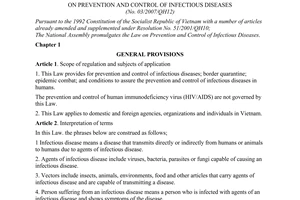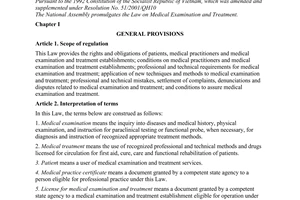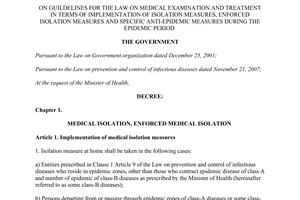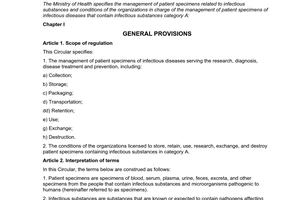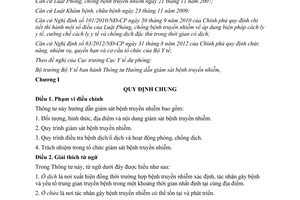Circular 13/2013/TT-BYT on guidelines for infectious disease surveillance đã được thay thế bởi Circular 17/2019/TT-BYT providing instructions about communicable disease surveillance response và được áp dụng kể từ ngày 01/09/2019.
Nội dung toàn văn Circular 13/2013/TT-BYT on guidelines for infectious disease surveillance
|
THE MINISTRY OF
HEALTH |
SOCIALIST
REPUBLIC OF VIETNAM |
|
No. 13/2013/TT-BYT |
Hanoi, April 17, 2013 |
CIRCULAR
ON GUIDELINES FOR INFECTIOUS DISEASE SURVEILLANCE
Pursuant to the Law on prevention and control of infectious diseases dated November 21, 2007;
Pursuant to the Law on Medical examination and treatment dated November 23, 2019;
Pursuant to the Government's Decree No. 101/2010/ND-CP dated September 30, 2010 on guidelines for the Law on Medical examination and treatment in terms of application of medical isolation, medical isolation enforcement and special epidemic control during the epidemic time;
Pursuant to the Government's Decree No. 63/2012/ND-CP dated August 31, 2012 defining the functions, tasks, powers and organizational structure of the Ministry of Health;
At the request of Director of General Department of Preventive Medicine;
The Minister of Health promulgates a Circular on guidelines for infectious disease surveillance,
Chapter I
GENERAL PROVISIONS
Article 1. Scope
This Circular provides guidelines for infectious disease surveillance, including:
1. Entities, forms, location and content of infectious disease surveillance.
2. Procedure for infectious disease surveillance.
3. Procedure for epidemic diseases/outbreaks and the prevention and control of epidemic.
4. Responsibilities in infectious disease surveillance.
Article 2. Interpretation of terms
For the purposes of this Circular, the following terms shall be construed as follows:
1. Outbreak means the place of simultaneous occurrences of infectious diseases, pathogens and vectors in a particular time at the same place.
2. Reservoir is the place where infectious pathogens can survive and develop.
Chapter II
ENTITIES, FORMS, LOCATION AND CONTENT OF INFECTIOUS DISEASE SURVEILLANCE
Article 3. Entities and infectious diseases subject to surveillance
1. Entities:
a) Persons contracting infectious diseases, persons suspected to contract infectious diseases and infectious disease carriers;
b) Pathogens of infectious diseases;
c) Reservoir, vectors and risks.
2. Infectious diseases subject to surveillance prescribed in Clause 1 Article 3 of the Law on prevention and control of infectious diseases, including a number of infectious diseases in group B of the Appendix of list of infectious diseases in group B subject to medical isolation issued herewith.
Article 4. Forms and types of surveillance
Infectious disease surveillance means the continuous and systematic collection of information on the situation and tendency of infectious diseases to supply information for the planning, implementation and evaluation of the effectiveness of measures against infectious diseases.
1. Forms:
a) Active surveillance: Through active investigation at surveillance spot.
b) Passive surveillance: Through reports sent from levels in the surveillance system.
2. Types:
a) Regular surveillance: through the monitoring and control of infectious diseases at a certain region or nationwide.
b) Sentinel surveillance: through surveillance units that are selected during a certain period of time.
c) Community-based surveillance: Through surveillance activities conducted by health workers, veterinary staff of communes, villages and statements of inhabitants.
d) Health facility-based surveillance: through reports sent by health facilities.
dd) Laboratory-based surveillance: through reports sent by laboratories.
Article 5. Locations
Infectious disease surveillance shall be carried out in the whole scope of management assigned, especially in the following locations:
1. Areas with outbreaks, areas with old outbreaks, or areas at risks of epidemics.
2. Health facilities.
3. Isolation areas of infectious diseases.
4. Places of residence, study, and work of persons diagnosed with affecting infectious diseases, persons suspected to contract infectious diseases and infectious disease carriers;
5. Checkpoint areas.
6. Areas where natural disasters, catastrophes have occurred.
Article 6. Content
1. Surveillance of sources of infectious diseases:
a) Persons contracting infectious diseases or suspected to contract infectious diseases;
b) Infectious disease carriers;
c) Animal contracting infectious diseases or suspected to contract infectious diseases;
d) Animal harboring pathogens of infectious diseases.
2. Surveillance of pathogens of infectious diseases:
a) Germs;
b) Viruses;
c) Rickettsia;
d) Parasitology.
3. Surveillance of reservoirs, vectors and risks:
a) Insects, animal, plants;
b) Food;
c) Environment: land, water, air;
d) Geography, climate, weather;
dd) Socio-economic factors: economy, living standards, behavior, lifestyle, customs, residential structure, ethnic structure;
e) Specimens;
g) Serum.
Chapter III
PROCEDURE FOR INFECTIOUS DISEASE SURVEILLANCE
Article 7. Steps of surveillance
1. Collecting information.
2. Analyzing data and evaluate results.
3. Assessing the situation of infectious diseases.
4. Proposing intervention measures.
5. Reporting.
Article 8. Information to be collected in surveillance
1. Sources of infectious diseases
a) Persons contracting infectious diseases, persons suspected to contract infectious diseases, infectious disease carriers, and persons who die from infectious diseases:
- Name, age, sex, occupation, place of residence:
- Location and duration of infection;
- Development, symptoms, diagnosis and treatment;
- History and related epidemiological factors.
b) The information about insects, animal, plants, objects suspected of infection sources: species, biological characteristics, density, and relationship with humans.
2. Identification of pathogens of infectious diseases: strains, groups, types, subtypes, biological characteristics of drug resistance, changes in forms and genes.
3. Transmission: transmitted through respiratory tract, gastrointestinal tract, skin contact, mucous membrane, blood, and vectors.
4. Reservoirs, vectors and risks
a) Insects, animal, plants, animals carrying pathogens. With regard to harmful/infected insects, the following must be determined: quantity, density, species, surveillance indicators, and sensitivity to chemicals;
b) Food: Materials, processing methods, and preservation,
c) Environment: land, water, air;
d) Geography, climate, weather: geography, seasons, temperature, rainfall, humidity;
dd) Socio-economic condition: economy, living standards, behavior, lifestyle, customs, residential structure, ethnic structure;
e) Specimens;
g) Serum.
5. Actions to control of infectious diseases
a) Measures to control infectious diseases;
b) The effect of these measures that have been initiated;
c) Disadvantages and advantages.
Chapter IV
PROCEDURE FOR INVESTIGATION OF EPIDEMIC DISEASES/OUTBREAKS AND THE PREVENTION AND CONTROL OF EPIDEMIC
Article 9. Steps of initiating an investigatory process of epidemic diseases/outbreaks
1. Prepare investigation of epidemic diseases/outbreaks.
2. Determine the existence of epidemic diseases/outbreaks.
3. Determine the criteria for diagnosis of the first person contracting or suspected of contracting the disease.
4. Describe the process of development of epidemic diseases/outbreaks by time, place and people.
5. Study the demographics, economics - society to detect receptor groups or groups at risk for epidemic diseases/outbreaks that have been identified.
6. Investigate factors related to the epidemic diseases/outbreaks specified in Clauses 1, 2, 3 and 4 of Article 8 of this Circular.
7. Synthesize, analyze, evaluate and provide definitive diagnosis of epidemic diseases/outbreaks, identify the source of infection, transmission lines and risk groups.
8. Identify, prognosis situation.
9. Recommend measures to prevention.
10. Report setting forth their findings about epidemic diseases/outbreaks.
Article 10. The collection, preservation, packaging, transportation, storage, use, research, exchange and destruction of specimens
1. The collection, preservation, packaging, transportation, storage, use, research, exchange and destruction of specimens shall be carried out in accordance with Circular No. 43/2011/TT-BYT dated December 5, 2011 of the Minister of Health on regulations on management of pathology specimens of infectious diseases.
2. In the case where a health facility is not capable of performing the tests identifying the pathogens should, it shall contact the health facility in order to send specimens, as well as guiding the collection, storage and transport of specimens.
Article 11. Responses to outbreaks
1. Preparation:
a) Human resources;
b) Budget for the investigation and responses to outbreaks;
c) Drugs, chemicals, biological, equipment for responding to outbreaks, emergency equipment and other medical devices;
d) Supposed support for prevention and control of epidemic (if necessary): levels to be supported, facilities, methods, time, supports of superior levels and interdisciplinary supports.
2. Epidemic prevention and control
The processing of prevention and control of epidemic/outbreaks, depending on the disease or syndrome on the basis of investigation results, include the following measures:
a) Treatment of pathogens:
- Collecting, treatment and management of cases;
- Medical isolation;
- Treatment of healthy people carrying the infectious diseases;
- Treatment of waste of human, animal and other infectious sources.
b) Treatment of disease transmission:
- Adoption of measures to prevent vectors;
- Sanitation, disinfection, and sterilization of epidemic zones.
c) Protection of healthy people:
- Hygiene, personal protective equipment;
- Food safety assurance;
- Implementation of vaccination;
- Raising public awareness of community health.
Article 12. Information and reporting
Complying with Circular No. 48/2010/TT-BYT dated December 31, 2010 by the Minister of Health on guidelines for declaration, information, and reporting of infectious diseases.
Chapter V
RESPONSIBILITIES IN INFECTIOUS DISEASE SURVEILLANCE
Article 13. Responsibilities of General Department of Preventive Medicine
1. Act as an advisor for Minister of Health to implement state management in developing, coordinating and directing all professional and technical operation in surveillance of infectious diseases nationwide.
2. Direct health facilities under preventive healthcare system, the Health Service of province, the health units of the preventive healthcare system to implement infectious disease surveillance.
3. Inspect, monitor and expedite the professional and technical infectious disease surveillance.
4. Send weekly, monthly, annual and irregular reports on infectious disease situation in the country and in the world to the Minister of Health.
Article 14. Responsibilities of Department of examination and treatment management
1. Instruct and direct the nationwide health facilities to appoint units in charge of infectious disease surveillance and infection prevention in health facilities depending on the scope of professional activities subjects to perform professional and technical infectious disease surveillance and declaration, information, and reporting of infectious diseases prescribed in Circular No. 48/2010 / TT-BYT of December 31, 2010 the Minister of Health.
2. Inspect, monitor and expedite the heath facilities to perform professional and technical infectious disease surveillance.
Article 15. Responsibilities of Institutes under Preventive Health System
1. Instruct and direct professional and technical aspects of, and inspect, monitor, and assess the professional and technical infectious disease surveillance at units at region levels and areas in charge.
2. Collect, analyze, evaluate, store data of infectious diseases surveillance, conduct reporting of , prevention and control of the infectious diseases of units at region levels and areas in charge.
3. Coordinate and share information about infectious disease surveillance among health facilities under Preventive Healthcare System.
Article 16. Responsibilities of Services of Health
1. Direct and guide the health facilities in the province to manage the implementation of professional and technical infectious disease surveillance.
2. Inspect, monitor and expedite the professional and technical infectious disease surveillance.
Article 17. Responsibilities of affiliated entities of Services of Health
1. Preventive health centers at province level shall implement the infectious disease surveillance in the provinces. Direct, guide, and monitor inferior units to implement professional and technical infectious disease surveillance.
2. International Health Quarantine Center shall implement professional and technical infectious disease surveillance at national and international border checkpoints in the provinces.
3. Other health centers under preventive health system shall implement professional and technical infectious disease surveillance according to their functions and tasks assigned.
4. Health centers at district level shall implement infectious disease surveillance in the district.
5. Health centers at commune level shall implement infectious disease surveillance in the commune.
Article 18. Responsibilities of health facilities
1. Appoint units in charge of and infection prevention surveillance and infection prevention at health facilities.
2. Implement professional and technical infectious disease surveillance.
3. Closely cooperate with health facilities under preventive health system in investigating and providing results of patients, sampling, and sharing of pathology specimens and strains of pathogens for diagnosis.
Article 19. Responsibilities of relevant Ministries and agencies
1. Direct, guide affiliated units to implement professional and technical infectious disease surveillance.
2. Inspect, monitor and expedite the professional and technical infectious disease surveillance.
Chapter VI
IMPLEMENTATION
Article 20. Term of reference
In the case where any of documents referred to in this document is replaced or amended, the replacing or amending document shall prevail.
Article 21. Effect
This Circular comes into forces from June 15, 2013.
Difficulties that arise during the implementation of this Circular should be reported to General Department of Preventive Medicine affiliated to the Ministry of Health for consideration.
|
|
PP. MINISTER |
APPENDIX
ON LIST OF CLASS-B
INFECTIOUS DISEASES SUBJECT TO MEDICAL ISOLATION
(Issued together with Circular No. 13/2013/TT-BYT dated April 17, 2013 on
guidelines for infectious disease surveillance)
The list consists of class-B infectious diseases with high infectivity and fatal probability.
1. Diphtheria.
2. Pertussis.
3. Measles.
4. Anthrax.
5. Diseases caused by meningococcus.
6. Hand-Foot-Mouth Disease (HFMD)
------------------------------------------------------------------------------------------------------
This translation is made by LawSoft and
for reference purposes only. Its copyright is owned by LawSoft
and protected under Clause 2, Article 14 of the Law on Intellectual Property.Your comments are always welcomed
